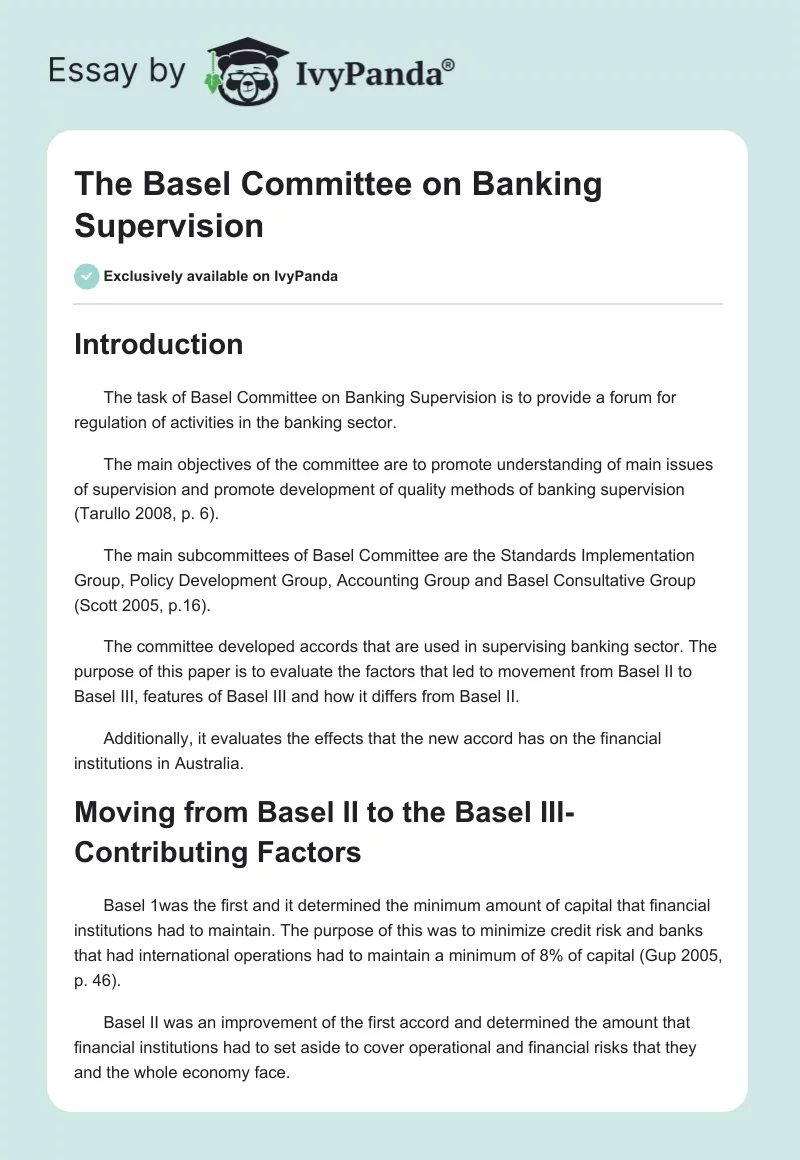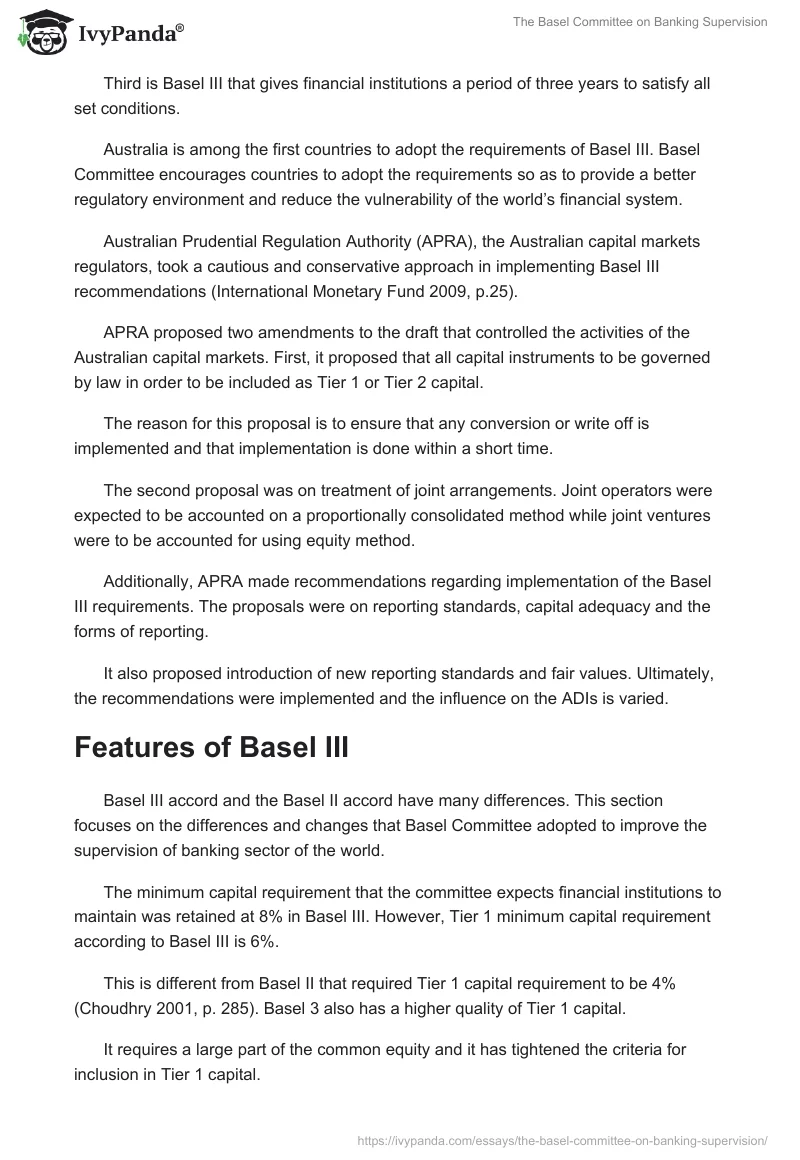Introduction
The task of Basel Committee on Banking Supervision is to provide a forum for regulation of activities in the banking sector.
The main objectives of the committee are to promote understanding of main issues of supervision and promote development of quality methods of banking supervision (Tarullo 2008, p. 6).
The main subcommittees of Basel Committee are the Standards Implementation Group, Policy Development Group, Accounting Group and Basel Consultative Group (Scott 2005, p.16).
The committee developed accords that are used in supervising banking sector. The purpose of this paper is to evaluate the factors that led to movement from Basel II to Basel III, features of Basel III and how it differs from Basel II.
Additionally, it evaluates the effects that the new accord has on the financial institutions in Australia.
Moving from Basel II to the Basel III- Contributing Factors
Basel 1was the first and it determined the minimum amount of capital that financial institutions had to maintain. The purpose of this was to minimize credit risk and banks that had international operations had to maintain a minimum of 8% of capital (Gup 2005, p. 46).
Basel II was an improvement of the first accord and determined the amount that financial institutions had to set aside to cover operational and financial risks that they and the whole economy face.
Third is Basel III that gives financial institutions a period of three years to satisfy all set conditions.
Australia is among the first countries to adopt the requirements of Basel III. Basel Committee encourages countries to adopt the requirements so as to provide a better regulatory environment and reduce the vulnerability of the world’s financial system.
Australian Prudential Regulation Authority (APRA), the Australian capital markets regulators, took a cautious and conservative approach in implementing Basel III recommendations (International Monetary Fund 2009, p.25).
APRA proposed two amendments to the draft that controlled the activities of the Australian capital markets. First, it proposed that all capital instruments to be governed by law in order to be included as Tier 1 or Tier 2 capital.
The reason for this proposal is to ensure that any conversion or write off is implemented and that implementation is done within a short time.
The second proposal was on treatment of joint arrangements. Joint operators were expected to be accounted on a proportionally consolidated method while joint ventures were to be accounted for using equity method.
Additionally, APRA made recommendations regarding implementation of the Basel III requirements. The proposals were on reporting standards, capital adequacy and the forms of reporting.
It also proposed introduction of new reporting standards and fair values. Ultimately, the recommendations were implemented and the influence on the ADIs is varied.
Features of Basel III
Basel III accord and the Basel II accord have many differences. This section focuses on the differences and changes that Basel Committee adopted to improve the supervision of banking sector of the world.
The minimum capital requirement that the committee expects financial institutions to maintain was retained at 8% in Basel III. However, Tier 1 minimum capital requirement according to Basel III is 6%.
This is different from Basel II that required Tier 1 capital requirement to be 4% (Choudhry 2001, p. 285). Basel 3 also has a higher quality of Tier 1 capital.
It requires a large part of the common equity and it has tightened the criteria for inclusion in Tier 1 capital.
Additionally, Basel III has increased the quality of Tier 2 capital and the inclusion criteria in Tier 2 capital have also been tightened.
Basel III also has a requirement that most capital deductions be made to Common Equity Tier 1 (CET1) instead of 50% from Tier 1 and 50% from Tier 2 as it was under Basel 2.
Tier 1 capital is that which is always available freely to take up losses without making the bank wind up operations while Tier 2 absorbs losses incases when a bank winds up.
The other feature of Basel III is the introduction of Conservation Buffer which is a new measure. Conservation Buffer aims at ensuring that financial institutions maintain a buffer capital which is above the minimum capital requirement (Gregoriou 2009, p. 198).
This capital buffer is to cushion banks in cases when they make losses especially during economic and financial down turns.
Banks will thus be able to draw from this buffer during such stressful periods. However, constraints in the spread of earnings during these periods will be applied as capital ratios of the banks get nearer to the minimum requirement.
Another feature of Basel III is the introduction of a Counter-cyclical Buffer of Common Equity and national circumstances are to determine the implementation of this buffer.
The intent of this action is to facilitate the achievement of vast macro-prudential factors. This is attainable through fortification of the banking sector from excessive expansion of credits. In addition to these features, Basel III strengthens the rules used in the calculation of risk weighted assets.
It also adds minimum requirements to ensure the protection of the tax payers. These minimum requirements are to ensure that the capital that a bank has is able to absorb losses in cases when a bank’s operations become non-viable.
Implications of Basel III in Australia
The implications of Basel III accord implemented in Australia are varied and are based on various circumstances.
The writing off or conversion of a regulatory instrument due to an event triggered by an issue to do with capital or non-viability has adverse effect on an ADI (Ayadi & Resti 2004, p. 37).
The affected ADI is likely to be at great loss in case of such an event and is not likely to make any profit. The reduction of the value of capital used in the regulatory instrument is thus considered to be harsh.
This is mainly when probability of a capital trigger event or a non-viability event occurring is low. Additionally, it is considered harsh when the probability of making losses is low or when the probability of making profit is high.
The other implication of Basel III is to add cost to the ADIs. The requirement that banks estimate their potential income tax has the effect of requiring banks to seek professional advice.
This also brings about compliance burden to ADIs. The adverse effect that this requirement has on ADIs includes ADIs having to raise 42% of additional capital. This event would mainly occur when there is disruption in the capital markets.
The disruption can be caused by uncertainty due to economic conditions or due to the need of the markets to use features that are new and untested (Mohamed, Farrar & Khalid 2012, p.134).
The other implication of Basel III accord is requiring the financial systems of the world to raise the large volume of requirements that the accord set.
It is not clear weather the capital markets of various countries will be able to raise the large volume. Generally, large capitals usually require that investors be paid margins that are high. The increase thus has the effect of increasing costs to the ADIs.
In addition to this, increase in demand for capital forces the ADIs to seek more funds offshore. However, funding from offshore markets may worsen the pressure that the ADIs have in their country and also increase the cost of funding (Hull 2012, p.289).
Increase in the cost of capital for the ADIs is the other implication of the Basel 3 implementation in Australia. The ADIs may respond to these changes by increasing the cost of their products.
Additionally, the supply of credit through loans is also likely to reduce due to the implementation of Basel 3. The competiveness of the ADIs is also likely to reduce due to the features of Basel 3. This is mainly because of the increase in the cost of capital for the ADIs.
They are also likely to become less competitive since their competitors in other countries are likely to refuse to accept the conditions set by Basel 3 (Chorafas 2012, p. 140).
The ADIs competitors are likely not to accept similar conditions due to issues such as tax laws in their countries, the additional capital requirement and the additional costs that accompany the conditions.
The conditions are also likely to increase the total industry cost in excess of $260 million per month.
Methodology
Basel Committee conducted data collection from various banks. The information collected was used to examine weather the committee’s goals had been met through the implementation of the recommendations.
An impact study was later conducted in which many banks were considered. Banks of different profiles were included in the study and the extent of their credit risk mitigation was also considered. Some of the analyses that were made were based on approximations due to lack of the necessary data.
Results
The study on the effect of the implementation of the Basel III recommendations found that the recommendations had both positive and negative effects on ADIs.
The recommendations had the effects of improving supervision of the banking sector and the capital markets. The implementation of the recommendations also had the effect of increasing the cost of capital for the ADIs.
They further had the likelihood of reducing the competitiveness of the ADIs internationally and also are likely to increase product prices of the ADIs.
In general, the recommendations are likely to increase Australia’s banking industry cost in excess of $260 million monthly.
Conclusion
The goals of Basel committee are to regulate actions in the banking sector worldwide. The committee has used different accords to set the standards for banking sector and capital markets and one of these is Basel III accord.
This paper sought to understand the reason for the adoption of the Basel 3 accord, its features and the implication that its implementation had on ADIs. The Basel 3 accord had various features that have been extensively discussed.
The implications of these features are to improve the quality of supervision in the banking sector, protection of the tax payers and reduce losses due to risk.
The implications that the recommendation had on ADIs are to increase the cost of capital, reduce the competitiveness of the ADIs internationally and add cost in the operations of the ADIs.
It further had the implication of reducing credit supply and increasing the prices of ADIs’ products.
The industry cost is estimated to increase by more than $260 million monthly. The overall conclusion is, however, that the Basel 3 features are important in reducing financial risks and countries should adopt them.
References
Ayadi, R & Resti, A 2004, The new Basel capital accord and the future of the European financial system, CEPS, London, UK.
Chorafas, D 2012, Basel III, the Devil and global banking, Palgrave Macmillan, Hampshire.
Choudhry, M 2001, The REPO handbook, Butterworth-Heinemann, Oxford, UK.
Gregoriou, G 2009, Operational risk toward Basel III: Best practices and issues in modeling, management and regulation, Wiley, Hoboken, NJ.
Gup, B 2005, Capital markets, globalization, and economic development, Springer, New York, NY.
Hull, J 2012, Risk management and financial institutions + website, Wiley, Hoboken, NJ.
International Monetary Fund 2009, Australia: 2009 Article IV consultation: staff report, and public information notice on the Executive Board discussion, IMF, Washington, DC.
Mohamed, A., Farrar, J & Khalid, A 2012, Regulatory failure and the global financial crisis: an Australian perspective, Edward Elgar, Cheltenham, UK.
Scott, H 2005, Capital adequacy beyond Basel banking, securities, and insurance, Oxford University Press, London, UK.
Tarullo, D 2008, Banking on Basel: the future of international financial regulation, Peterson Institute for International Economics, Washington, DC.


